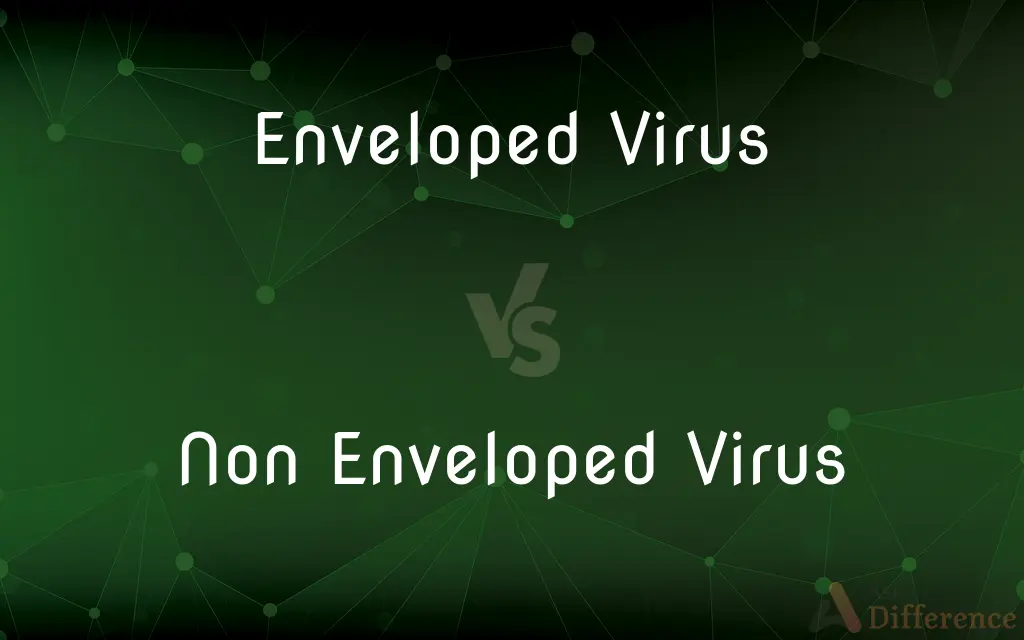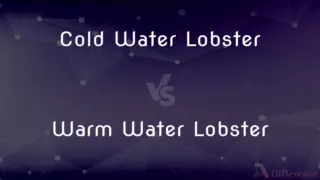Enveloped Virus vs. Non Enveloped Virus — What's the Difference?
By Tayyaba Rehman & Urooj Arif — Published on December 5, 2024
Enveloped viruses have a lipid outer layer, aiding in host cell entry and immune evasion, while non-enveloped viruses lack this layer, making them more resilient outside the host.

Difference Between Enveloped Virus and Non Enveloped Virus
Table of Contents
ADVERTISEMENT
Key Differences
Enveloped viruses possess a lipid bilayer derived from the host cell membrane, which encases their capsid. This envelope plays a crucial role in the virus's ability to fuse with host cells and evade the host's immune system. On the other hand, non-enveloped viruses lack this lipid envelope, relying on more robust capsids to protect their genetic material and to facilitate entry into host cells.
The envelope in enveloped viruses facilitates a wider range of entry mechanisms into host cells, such as direct fusion with the host cell membrane or receptor-mediated endocytosis. Whereas, non-enveloped viruses often rely on simpler, more direct methods to penetrate host cells, such as creating pores in the cell membrane or being endocytosed without fusion.
Enveloped viruses tend to be more sensitive to environmental conditions, such as detergents and desiccation, because their lipid envelopes can be easily disrupted. Conversely, non-enveloped viruses are generally more stable and resistant to harsh conditions, making them capable of surviving in more challenging environments.
The immune response to enveloped viruses often involves antibodies that target the envelope proteins, preventing the virus from binding to and entering host cells. In contrast, the immune response to non-enveloped viruses may focus more on capsid proteins and often requires different strategies for neutralization.
Vaccines developed against enveloped viruses might target envelope proteins to block entry into host cells. Meanwhile, vaccines for non-enveloped viruses might aim to elicit an immune response against the capsid proteins, preventing the virus from attaching to or penetrating host cells.
ADVERTISEMENT
Comparison Chart
Outer Layer
Lipid envelope
No lipid envelope
Entry Mechanism
Fusion with host cell, receptor-mediated endocytosis
Direct penetration, endocytosis without fusion
Environmental Stability
Less stable, sensitive to detergents
More stable, resistant to detergents and desiccation
Immune Evasion
Evasion through envelope variation
Relies on capsid robustness
Vaccine Target
Envelope proteins
Capsid proteins
Compare with Definitions
Enveloped Virus
Utilizes complex entry mechanisms.
Herpes simplex virus, an enveloped virus, fuses with cellular membranes to infect cells.
Non Enveloped Virus
Challenging vaccine targets.
Vaccines for non-enveloped viruses like HPV target the capsid proteins.
Enveloped Virus
A virus with a lipid outer layer.
The influenza virus, an enveloped virus, uses its envelope to enter host cells.
Non Enveloped Virus
Employs direct entry methods.
The norovirus, non-enveloped, penetrates cells through breaches in the cell membrane.
Enveloped Virus
Sensitive to environmental changes.
Enveloped viruses like HIV are inactivated by alcohol-based sanitizers.
Non Enveloped Virus
A virus lacking a lipid outer layer.
The poliovirus, a non-enveloped virus, is highly stable outside the host.
Enveloped Virus
Evades immune detection.
Enveloped viruses like the flu change their envelope proteins to escape immunity.
Non Enveloped Virus
Resistant to harsh environments.
Non-enveloped viruses like adenovirus can survive on surfaces for extended periods.
Enveloped Virus
Targets for vaccine development.
Vaccines against the enveloped Hepatitis B virus aim at its surface antigens.
Non Enveloped Virus
Relies on capsid for protection.
Non-enveloped viruses protect their genetic material with a tough capsid.
Common Curiosities
Why are enveloped viruses more sensitive to detergents?
The lipid envelope of enveloped viruses can be easily disrupted by detergents, leading to their inactivation.
Can vaccines target non-enveloped viruses effectively?
Yes, vaccines can effectively target non-enveloped viruses by eliciting an immune response against the capsid proteins.
Why are enveloped viruses less stable in the environment?
Enveloped viruses are less stable because their lipid envelopes are sensitive to environmental factors like desiccation and detergents, which can disrupt their integrity.
What distinguishes an enveloped virus from a non-enveloped virus?
The main distinction is the presence of a lipid envelope in enveloped viruses, which aids in entry and evasion, whereas non-enveloped viruses lack this layer and have more resilient capsids.
How do non-enveloped viruses enter host cells?
Non-enveloped viruses enter host cells through more direct methods, such as creating pores in the cell membrane or being endocytosed without requiring fusion.
How do enveloped and non-enveloped viruses differ in vaccine development?
Vaccine development for enveloped viruses often targets envelope proteins, whereas for non-enveloped viruses, it targets capsid proteins to prevent infection.
Are non-enveloped viruses more resistant to environmental conditions?
Yes, non-enveloped viruses are more resistant to environmental conditions due to their robust capsids, which protect their genetic material without needing a lipid envelope.
Can enveloped viruses evade the immune system?
Yes, enveloped viruses can evade the immune system by altering their envelope proteins, making it difficult for the immune system to recognize and neutralize them.
How do immune systems respond to enveloped viruses?
The immune system often targets the envelope proteins of enveloped viruses to prevent them from binding to and entering host cells.
What role does the envelope play in viral infection?
The envelope facilitates viral entry into host cells through mechanisms like fusion and receptor-mediated endocytosis and helps in immune evasion by varying envelope proteins.
Share Your Discovery

Previous Comparison
Dallas vs. Houston
Next Comparison
Jealous vs. TerritorialAuthor Spotlight
Written by
Tayyaba RehmanTayyaba Rehman is a distinguished writer, currently serving as a primary contributor to askdifference.com. As a researcher in semantics and etymology, Tayyaba's passion for the complexity of languages and their distinctions has found a perfect home on the platform. Tayyaba delves into the intricacies of language, distinguishing between commonly confused words and phrases, thereby providing clarity for readers worldwide.
Co-written by
Urooj ArifUrooj is a skilled content writer at Ask Difference, known for her exceptional ability to simplify complex topics into engaging and informative content. With a passion for research and a flair for clear, concise writing, she consistently delivers articles that resonate with our diverse audience.













































